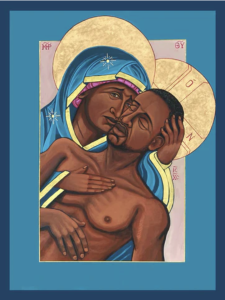This is the second in a four-part series BNG will publish every Monday during Advent.
A few years ago, I preached on the Sunday after Christmas, low attendance Sunday, a regular occurrence for an associate pastor (and a woman) like me. In that sermon I shared that my least favorite Christmas song is “Mary, Did You Know?” In sharing that sentiment, I offended several congregants who had long held it as their favorite. They teased that I ruined it for them.

Julia Goldie Day
The lyrics to “Mary, Did You Know?” were written by Mark Lowry in 1984, and in terms of Christmas music, it is still fairly new. Since then, it’s been covered by many talented and popular artists including Kelly Clarkson, Pentatonix and Amy Grant.
Mary, did you know that your baby boy
Is Lord of all creation?
Mary, did you know that your baby boy
Would one day rule the nations?
Did you know that your baby boy
Is heaven’s perfect Lamb?
That sleeping child you’re holding is the great, I Am
The author explains he was imagining what questions he would ask Mary if he got to sit down and have a cup of coffee with her. Problem is, Mary already told him the answers to his questions. He didn’t take the time to listen to Mary’s voice or her story. She told him everything that took place and all that was to come with the good news she shares with us in the beginning of the Gospel of Luke.
“Mary already told him the answers to his questions. He didn’t take the time to listen to Mary’s voice or her story.”
My issue with “Mary, Did You Know?” is that it ignores the prominence of Mary and sends her to the background of her own story. Michael Frost has suggested it is the “most sexist Christmas song ever written. … It treats her like a clueless child. … Could you imagine a song asking Abraham 17 times if he knew he’d be the father of a great nation?”
Mary knew, and we know Mary knew, because the angel told her and because of her own words of hope and praise, a song known as the “Magnificat,” found in Luke’s first chapter.
Cindy Sadler’s parody of “Mary, Did You Know?” called “Mary Responds,” performed by Charissa Memrick, is hilariously accurate when she says, as Mary, “Yes, I freakin’ knew” and “When you mansplained my own pregnancy you’re acting dumb and rude.”
In my freshman year of college choir, we performed John Rutter’s arrangement of Mary’s song, “Magnificat,” which was mostly in Latin. Of course, I probably had heard this Scripture from Luke chapter 1 read in church and maybe even read it myself, but I didn’t know its significance. I certainly hadn’t been told that Mary was proclaiming the gospel as a prophet in her own right or that this was the longest speech by a woman in the New Testament.
At first, I struggled with the rest of the choir to learn the Latin, but we slowly began to grasp the beauty and complexity of this musical expression of hope and faith. It is perhaps my favorite memory of choral performance and an important part of my journey of faith. Although I had little understanding of what I sang, I felt its power and beauty intuitively.
Similarly, “Ave Maria” fascinated me when I sang it in high school choir — this was not how my Baptist church celebrated Christmas. There was mystery, power and beauty I had yet to explore.
Sadly, one Baptist church I served would not agree to a very talented and accomplished soprano singing “Ave Maria” at my suggestion. Listening to the song of Mary, as Baptists, even in Latin can teach us how to honor this woman and the importance of her role.
Mary knew “her baby boy was Lord of all creation” as the song goes. Elizabeth also knew, and exclaims to her, “Blessed are you among women, and blessed is the fruit of your womb. And why has this happened to me, that the mother of my Lord comes to me?”
This mother isn’t quiet or inactive. Mary questions the angel, she agrees to what the angel has said, and she is obedient. Then she boldly sings of the new kin’dom God is bringing into the world, where God lifts up the lowly and the poor.
Dietrich Bonhoeffer called the Magnificat “the most passionate, the wildest, one might even say the most revolutionary hymn ever sung.”
“This song is for the forgotten, the poor, the powerless, the abused.”
Perhaps it’s revolutionary because people in power would be threatened by its message. Those entrenched in the status quo and people with religious authority and influence have little to love in this message of subversion. This song is for the forgotten, the poor, the powerless, the abused.
God is on the side of the lowly and is at work to lift them up and tear the powerful down. Yes, it is revolutionary and dangerous. This is a redemption story that will bring us home, a place of peace and abundance for all.
This proclamation is about more than the birth of Jesus; it is the birth of kin’dom, and Mary knows its song.
Henri Nouwen said: “The mother of the suffering Jesus asks more — that ‘we let our hearts be broken by the anguish of our world. Mary calls me back to where I most want to be: to the heart of God which … is also the heart of the world.’”

“Mama,” by Kelly Latimore
The heart of God, the heart of the world. Mary is displayed for us to aspire to her model. “God’s regard for one humble woman” becomes the sign of God working in the world — if we have ears to listen to her song.
Mary ponders these things in her heart. She knows.
The flesh of her flesh also has a role to play. A life to live — a song to sing — for us to follow that comes from her very being, and a death to come that will pierce her own heart.
Mary is with her suffering son at the end after many of the men have fled. Full of grace, as depicted in the Gospel of John, she hears her son’s words of care for her. The disciple John will take her into his own home at Jesus’ bequest. Even though Mary has other sons, Jesus is purposefully creating kin — a new family of God.
Tradition holds that the body of Jesus was laid in the arms of his mother one last time before it was taken away to the tomb. The pieta or compassion of Mary is most famously portrayed in sculpture by the Renaissance artist Michelangelo. In this portrayal of Mary, we see her holding the body of her son. The artist described this depiction as “the heart’s image.” For me this image is more heartbreaking than the gruesome images of the crucifixion; it is soul piercing in its humanity.
I can’t help but think of the final words of another son, George Floyd, who called for his mother with his last breath. It is a deeply human need to call for the compassion of our mothers, for mothers to reach out with love to children even if we may never reach them.
This is the heart of God.
We can see this nature of God in mothers. Mothers are wise and knowing, despite what Mark Lowry’s song says. We are compassionate and we are strong even in times of unspeakable loss and tragedy. Mary was one such mother.
How will you be changed by the leadership of Mary’s Song this Advent and Christmas?
A few alternative creative expressions to experience:
- Watch The Nativity Story movie, which centers Mary’s knowing experience as the mother of God.
- Watch Cindy Sadler’s parody of “Mary Did You Know” called “Mary Responds” performed by Charissa Memrick.
- Read “Mary Speaks,” a poem by Madeline L’Engle from her book Miracle on 10th Street. The entire book makes for a meaningful Advent and Christmas devotional.
- Listen to “Magnificat,” “Ave Maria,” and “Pie Jesu” as women and men sing of the great love of Mary and Jesus. If traditional music isn’t your thing, listen to other voices like Patty Griffin’s “Mary,” which inspired one of my oil paintings or the The Highwomen’s song “Highwomen” featuring Yola, telling the stories of women who paid the ultimate price for their own freedom and agency, singing, “we carry the sons you can only hold.”
- Read They Were Sons by Rita Omokha about 15 mothers who lost their Black sons at the hands of police.
As you experience these creative expressions, may you be changed by the heart of God. May you find your own song of love and compassion in the art of living. And may we all sing the songs we were created to sing with our lives as we join God’s revolution of love.
Julia Goldie Day is ordained through the Cooperative Baptist Fellowship and lives in Memphis, Tenn. She is a painter and proud mother to Jasper, Barak and Jillian. Learn more at her website.
Related articles:
Introducing BWIM Month of Advocacy | Opinion by Meredith Stone
Mary, our mother (for Baptists): There’s something about Mary | Opinion by Julia Goldie Day
The consent of mothers | Opinion by Julia Goldie Day
The sorrows of motherhood: Depictions of Mary’s sadness at the death of Christ | Analysis by Mallory Challis


